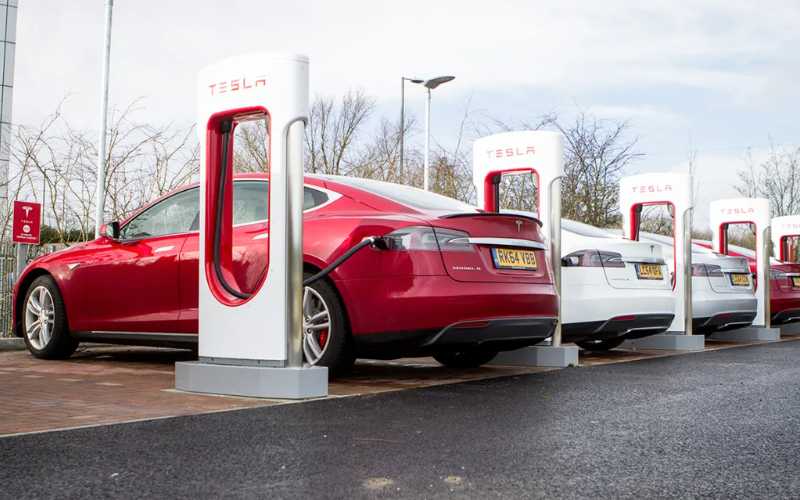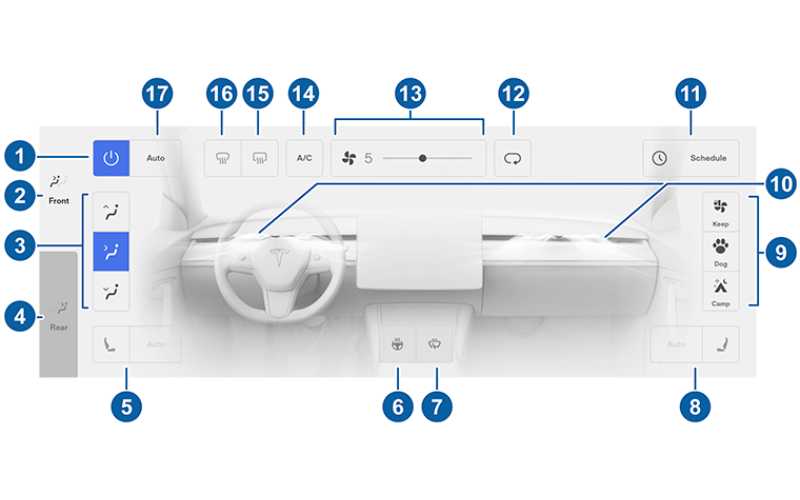Picture this: you’re cruising down the road in your Tesla, enjoying the thrill of an electric ride, when suddenly, the temperature inside the car starts to rise uncomfortably.
You glance at the touchscreen, hoping to bring a wave of cool air to the rescue, but to your dismay, the Tesla air conditioning is not working as expected.
Your comfort is at stake, and it’s time to unravel the mystery behind why your Tesla AC is blowing hot air when it should be delivering a refreshing blast of coolness.
In this article, we’re diving straight into the heart of the matter, uncovering the common reasons behind Tesla air conditioning issues and providing you with practical solutions to get your AC back in the game.
Before you attempt any fix, try rebooting the center console touchscreen first by pressing and holding both steering wheel scroll buttons until the screen goes off. More often than not, the issue is caused by software glitch and gets resolved after a reboot.
Tesla Air Conditioning Reduced Error
Here, we will delve deeper into the potential reasons for reduced air conditioning and offer detailed solutions.

Battery Temperature Control in Extreme Temperature
Tesla vehicles are equipped with advanced battery management systems to ensure the longevity and performance of their electric powertrains.
In extreme temperature conditions, the vehicle’s primary focus might shift to maintaining the battery’s optimal operating temperature, potentially leading to a reduction in air conditioning capacity.
Solution:
While you may not be able to entirely override the vehicle’s battery temperature control strategy, you can take steps to mitigate the discomfort:
Precondition the Cabin: Use the Tesla mobile app or schedule preconditioning before entering the vehicle. This allows the AC system to begin cooling the cabin while the car is still plugged in or connected to a power source.
Adjust Temperature Settings: Lower the cabin temperature setting to a comfortable level, which may encourage the system to prioritize cabin comfort while still managing battery temperature.
Avoid Extreme Heat: If you are stranded in extreme heat for a long period, this could heat up your battery temperature. As a result, it will cause your Tesla system to reduce cooling in the cabin and divert the power to manage the battery temperature.
The best way to deal with it is to go to a comfortable weather and let the system cool down.
Supercharging / DC Fast Charging Causing Heated Battery
During high-speed charging at superchargers or DC fast charging stations, the battery can heat up significantly due to the rapid transfer of energy.
To safeguard the battery from overheating, Tesla vehicles may temporarily reduce air conditioning performance.

Solution:
Patience is key when using fast chargers. The vehicle’s temporary reduction in air conditioning is a protective measure. Once the battery temperature stabilizes, the air conditioning will return to normal operation. You can also try the following:
- Limit Supercharging Power: If you’re not in a hurry, manually limit the charging power to a lower rate using the touchscreen display to reduce the stress on the battery and minimize temperature rise.
EVAP Temperature Sensor Malfunction
The EVAP (Evaporator) temperature sensor is a crucial component that monitors the temperature of the evaporator, helping to regulate the air conditioning system. If this sensor malfunctions, it can cause irregular cooling performance.
Solution: If you suspect a malfunctioning EVAP temperature sensor, follow these steps:
- Check for Error Messages: Look for any error messages or notifications on the touchscreen display related to the air conditioning system.
- Schedule a Service Appointment: Contact your nearest Tesla service center and describe the issue. They will perform a diagnostic test to confirm the problem and replace the sensor if necessary.
Refrigerant Issue
Refrigerant is the lifeblood of an air conditioning system. Low refrigerant levels due to leaks or other issues can significantly reduce cooling capacity.
Solution: To address a potential refrigerant issue:
- Check for Refrigerant Leaks: Inspect your garage or parking spot for any signs of refrigerant leakage, such as puddles or oily residue.
- Schedule a Professional Inspection: If you suspect a refrigerant problem, it’s essential to consult a Tesla service center. They have the equipment and expertise to detect and repair refrigerant leaks and recharge the system as needed.
By understanding the reasons behind reduced air conditioning performance in your Tesla and implementing the appropriate solutions, you can enjoy a more comfortable driving experience, even in challenging weather conditions.
Tesla AC Blowing Hot Air
Having your Tesla’s air conditioning blow hot air when you expect cooling can be frustrating, especially during the hot summer months. Now, we’ll explore the possible causes of the issue and provide comprehensive solutions.
AC Settings Issue
Sometimes, the air conditioning may appear to be blowing hot air due to incorrect settings. It’s important to ensure that you have selected the cooling mode and set the desired temperature correctly.
Solution: To rule out a settings issue:
Check Temperature Settings: Verify that you’ve set the temperature to a level that would trigger cooling. By default, climate control in Tesla is set Auto. Access the climate control settings by tapping on the temperature bottom of the display.
After you are in the climate control settings, select the start button (#1 in image) to activate manual settings.

Check Fan Speed: Ensure that the fan speed is set to an appropriate level for efficient cooling. In the case of hot air blowing issue, turn the slider all the way to the right. (#13 in image)
However, make sure A/C is turned on. The button is numbered 14.
Check AC Mode: Make sure you have selected the cooling mode (usually indicated by a snowflake or a “Cool” icon) and not the heating or ventilation mode.
Climate Control System Malfunction
A malfunction in the climate control system can result in the AC blowing hot air. This system is responsible for regulating temperature, airflow, and distribution within the cabin.
Solution: To address a potential climate control system malfunction:
Reboot the Touchscreen Display:
- Park the car.
- Restart the touchscreen display by holding down both scroll wheels on the steering wheel
- Keep holding the buttons down until the screen goes black and the Tesla logo reappears.
This can sometimes resolve software-related issues affecting the climate control system.
Check for Software Updates:
Ensure that your Tesla’s software is up to date. Some software updates may include bug fixes that address AC-related issues.
Refrigerant Leak
A refrigerant leak is a common cause of hot air blowing from the AC vents. Low refrigerant levels can prevent the system from effectively cooling the air.
Solution: To address a refrigerant leak:
- Visual Inspection: Look for any signs of refrigerant leakage in your garage or parking spot, such as puddles or oily residue.
- Professional Inspection: If you suspect a refrigerant issue, it’s essential to consult a Tesla service center. They have the tools and expertise to detect and repair refrigerant leaks, as well as recharge the system as necessary.
I don’t recommend attempting any DIY tricks to solve this as things can quickly get messy costing you more than expected at the end.
Issues with Condenser Coil
The condenser coil plays a vital role in the air conditioning process by releasing heat from the refrigerant. Damage or dirt on the condenser coil can hinder cooling performance.
Solution: To maintain optimal condenser coil performance:
- Regular Cleaning: Periodically inspect and clean the condenser coil. Ensure that it is free from debris, dirt, or blockages that could impede heat dissipation.
- Professional Maintenance: If you’re not comfortable cleaning the condenser coil yourself, consider scheduling professional maintenance with a Tesla service center.
Software Bug
Occasionally, software bugs can affect the AC’s performance. Tesla regularly releases software updates to address such issues.
Ensure that your Tesla’s software is up to date. If an update is available, install it to address any software bugs that may be causing AC problems.
You can go to Controls > Software to see if there is any update available. If there is an update available, you should see prompts to install it. Follow the onscreen instructions and you will be good to go.
Reach Tesla Support
If you have tried the above solutions and your Tesla’s AC continues to blow hot air, it’s time to reach out to Tesla’s customer support or schedule a service appointment.
Tesla’s trained technicians have the expertise and diagnostic tools needed to identify and address more complex AC issues.
Wrap Up
Tesla’s air conditioning system is a remarkable feature that enhances the overall driving experience.
While issues may arise from time to time, most can be resolved through simple troubleshooting or with the assistance of Tesla’s dedicated service team.
Remember to perform regular maintenance and keep your vehicle updated to enjoy the full benefits of your Tesla’s advanced climate control system.

